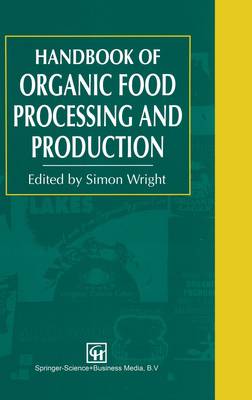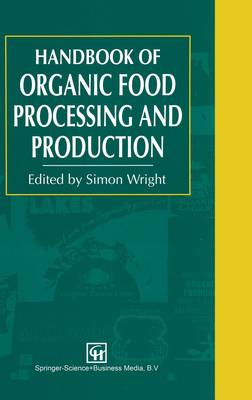
- Retrait gratuit dans votre magasin Club
- 7.000.000 titres dans notre catalogue
- Payer en toute sécurité
- Toujours un magasin près de chez vous
- Retrait gratuit dans votre magasin Club
- 7.000.000 titres dans notre catalogue
- Payer en toute sécurité
- Toujours un magasin près de chez vous
151,45 €
+ 302 points
Description
1 Introduction.- 1.1 Introduction.- 1.2 Organic farming.- 1.3 Conversion.- 1.4 Conservation grades.- 1.5 The cost of organic farming.- 1.6 How subsidies make organic farming uncompetitive.- 1.7 How does it work?.- 1.8 First World agriculture and Third World poverty.- 1.9 Fair trade and organic farming.- 1.10 History of the UK organic movement.- 1.11 Market size and share.- 1.12 Producers, processors and marketeers.- References.- 2 UK and European Community (EC) legislation.- 2.1 Introduction.- 2.2 Situation in the UK and the EC prior to EC legislation.- 2.3 Development of EC legislation.- 2.4 Summary of EC legislation as at 30 October 1993.- 2.4.1 Council Regulation 2092/91.- 2.4.2 Commission Regulation 94/92.- 2.4.3 Commission Regulation 1535/92.- 2.4.4 Council Regulation 2083/92.- 2.4.5 Commission Regulation 3457/92.- 2.4.6 Commission Regulation 3713/92.- 2.4.7 Commission Regulation 207/93.- 2.4.8 Commission Regulation 1593/93.- 2.4.9 Commission Regulation 2608/93.- 2.4.10 Commission Regulation 468/94.- 2.4.11 Commission Regulation 688/94.- 2.5 Structure of the EC legislation.- 2.6 Future developments on standards.- 2.7 Aid for organic farming.- 2.8 Overview.- References.- 3 Organic certification and the importation of organically produced foods.- 3.1 Introduction.- 3.2 Organic certification and its importance.- 3.3 Organic standards and certification protocol.- 3.4 Development of organic certification as a legal requirement.- 3.5 The structure of organic certification schemes in the EU.- 3.6 Certification protocol.- 3.6.1 Determination of eligibility of a business for organic certification.- 3.6.2 Making an application.- 3.6.3 Inspection.- 3.6.4 Post-inspection activities and certification.- 3.7 Imports of organically produced foods.- 3.7.1 Imports from approved Third Countries.- 3.7.2 Imports from non-approved Third Countries.- 3.8 The dynamics of organic certification.- Acknowledgement.- References.- 4 Fruit and vegetables.- 4.1 Introduction.- 4.2 Market structure and history.- 4.3 Availability.- 4.4 Growing systems compared.- 4.4.1 Non-organic growing systems.- 4.4.2 Organic growing systems.- 4.5 Types of market.- 4.5.1 Wholesale market.- 4.5.2 Supermarkets.- 4.5.3 Manufacturing/processing.- 4.6 Imports.- 4.7 Market overview.- 4.8 The future.- 5 Cereal products.- 5.1 Principal crops.- 5.1.1 Availability.- 5.1.2 Quality.- 5.2 Producing organic cereals.- 5.3 Processing requirements.- 5.3.1 Audit trail.- 5.3.2 Handling and processing.- 5.3.3 Ingredients.- 5.4 Existing products.- 5.5 Summary.- 6 Organic meat and meat products.- 6.1 Introduction.- 6.2 Legislation.- 6.3 Organic meat production.- 6.3.1 Production standards.- 6.3.2 Production systems.- 6.4 Processing and marketing organic meat.- 6.4.1 Processing standards.- 6.4.2 Marketing.- 6.5 Some practical processing and marketing considerations.- 6.5.1 Slaughtering and cutting organic meat.- 6.5.2 Retail outlets.- 6.5.3 Processed foods.- Acknowledgement.- References.- 7 Dairy products.- 7.1 Introduction.- 7.2 The significance of milk.- 7.3 Milk quality.- 7.4 Animal husbandry on an organic dairy farm.- 7.4.1 Organisation.- 7.4.2 Living conditions.- 7.4.3 Feeding.- 7.4.4 Treating disease.- 7.4.5 Breeding.- 7.4.6 Weaning.- 7.5 Liquid milk processing.- 7.6 Cheese production.- 7.7 Yogurt making.- 7.8 Cream and butter production.- 7.9 Ice-cream and frozen yogurt production.- 7.10 Marketing organic dairy products.- 7.11 Market development.- 7.12 Types of organic dairy units.- 7.12.1 Processing on-farm.- 7.12.2 The independent dairy.- 7.12.3 The specialist organic dairy.- 7.13 Legislation.- 7.14 Summary.- 8 Other organic processed foods.- 8.1 Introduction.- 8.2 Organic spreads.- 8.2.1 Jams/pure fruit spreads.- 8.2.2 Nut butters.- 8.2.3 Chocolate and carob spreads.- 8.2.4 Tahini.- 8.2.5 Honey.- 8.3 Organic juices and grain syrups.- 8.3.1 Fruit and vegetable juices.- 8.3.2 Grain-based syrups.- 8.4 Organic sauces and pickles.- 8.4.1 Sauces.- 8.4.2 Pickles and olives.- 8.4.3 Mustard...
Spécifications
Parties prenantes
- Auteur(s) :
- Editeur:
Contenu
- Nombre de pages :
- 228
- Langue:
- Anglais
Caractéristiques
- EAN:
- 9780751400458
- Date de parution :
- 31-12-95
- Format:
- Livre relié
- Format numérique:
- Genaaid
- Dimensions :
- 163 mm x 242 mm
- Poids :
- 557 g







